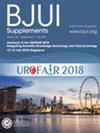空间组学教给我们的是前列腺癌和膀胱癌的癌变。
IF 3.7
2区 医学
Q1 UROLOGY & NEPHROLOGY
引用次数: 0
摘要
背景与目的肿瘤化是导致一组细胞在转化为癌症之前获得某些癌症表型变化的过程。在临床上,一个重要的挑战仍然是区分癌变场内的无性系和微环境的能力,这些无性系和微环境将保持惰性,而那些将发展为恶性转化。空间“组学”可以帮助我们研究遗传、表观遗传、转录组学、蛋白质组学和细胞微环境,这些微环境将正常细胞转化为癌变场,并随后转化为癌症。在这篇综述中,我们将讨论空间组学技术如何扩展了我们对前列腺癌和膀胱癌野区癌变的理解,以及与此研究相关的挑战。方法:筛选膀胱癌和前列腺癌现场癌变相关的关键文献。特别强调的是使用现代空间分析技术的研究和旨在调查正常组织内变化的研究,而不是简单地将其用作肿瘤组织的对照。结果:空间组学研究已经确定了一些有趣的早期发现,这些发现有助于我们理解:前列腺癌良性上皮的转化和前列腺内克隆扩增的机制;正常尿路上皮内克隆扩增;膀胱内癌变区域特有的突变;以及场癌如何使尿路上皮为癌症转化做好准备。结论野癌的空间组学分析可以为风险分层和个性化治疗方案提供信息。然而,在空间组学的潜力可以在临床实践中充分实现之前,必须克服许多与技术相关的挑战。本文章由计算机程序翻译,如有差异,请以英文原文为准。
What spatial omics is teaching us about field cancerisation in prostate and bladder cancer.
BACKGROUND AND OBJECTIVES
Field cancerisation is the process that results in a group of cells acquiring some of the phenotypic changes of cancer prior to transformation into cancer. Clinically, an important challenge remains the ability to distinguish clonal lineages and microenvironments within cancerised fields that will remain indolent from those that will progress to malignant transformation. Spatial 'omics' can help us investigate genetic, epigenetic, transcriptomic, proteomic, and cellular microenvironments that transform normal cells into a cancerised field, and subsequently into cancer. In this review, we will discuss how spatial omics techniques have expanded our understanding of field cancerisation in prostate and bladder cancer, and the challenges associated with this research.
METHODS
We identified key articles relating to field cancerisation in bladder and prostate cancer. Special emphasis was placed on studies that used modern spatial profiling technologies and studies that were designed to investigate changes within normal tissue rather than simply using it as a control for tumour tissue.
RESULTS
Spatial omics research into field cancerisation has identified interesting early findings that have informed our understanding of: transformation of the benign epithelium and mechanisms of intra-prostatic clonal expansion for prostate cancer; clonal expansion within the normal urothelium; mutations that are unique to cancerised fields within the bladder; and how field cancerisation may prime the urothelium for cancer transformation.
CONCLUSIONS
Spatial omics profiling of field cancerisation can inform risk stratification and personalised treatment options. However, there are a number of challenges associated with the technologies that must be overcome before the potential of spatial omics can be fully realised in clinical practice.
求助全文
通过发布文献求助,成功后即可免费获取论文全文。
去求助
来源期刊

BJU International
医学-泌尿学与肾脏学
CiteScore
9.10
自引率
4.40%
发文量
262
审稿时长
1 months
期刊介绍:
BJUI is one of the most highly respected medical journals in the world, with a truly international range of published papers and appeal. Every issue gives invaluable practical information in the form of original articles, reviews, comments, surgical education articles, and translational science articles in the field of urology. BJUI employs topical sections, and is in full colour, making it easier to browse or search for something specific.
 求助内容:
求助内容: 应助结果提醒方式:
应助结果提醒方式:


